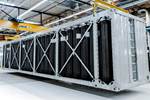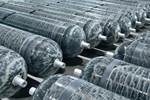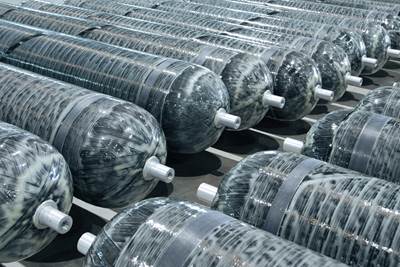Rational exuberance for emerging markets
Advanced air mobility and hydrogen storage represent a huge opportunity for the composites industry. They will also be hugely challenging.

Photo Credit: Getty Images
As disruptive as the pandemic has been, it has also helped stimulate growth in a number of composites markets that were either in their infancy pre-pandemic and continued to evolve, or were nascent and set on a new, accelerated path to maturity. I would argue that advanced air mobility (AAM) is the former, and hydrogen storage is the latter.
There is a certain amount of excitement here about the potential for unprecedented composites use that could set the industry in directions that, even a few years ago, were not imagined. Each of these end markets also needs composites in a way that it doesn’t need for any other material.
Let’s take AAM. Aircraft in this market will be fully battery powered, seat 4-6 people or carry equivalent cargo, take off and land vertically and provide transport over a range of 20 to 150 kilometers. Passenger service will be mostly air taxi, taking riders to or from city centers, with service starting in some cities in 2023-2024. Aircraft weight, particularly given the need to maximize range, is paramount, and only composite primary structures can meet the strength, stiffness and mass requirements of the AAM aircraft in development.
Demand for hydrogen storage, on the other hand, is not confined to a single vertical market, but is being deployed across multiple spaces, including aerospace, automotive, mass transit, trucking, rail and ocean shipping. In aerospace, hydrogen will likely be deployed for direct combustion, but in all other markets, it will be used in fuel cells. The value and performance proposition of composites in hydrogen storage is similar to that in AAM: Carbon fiber-overwrapped pressure vessels (COPVs) provide weight and strength properties that make them indispensable to hydrogen storage and transport.
AAM and hydrogen represent unprecedented opportunities for growth and also unprecedented challenges.
The excitement surrounding AAM and hydrogen storage can be infectious. AAM, when it reaches full maturity in the early 2030s, according to some estimates, could produce as many as 100,000 aircraft per year — an unprecedented amount for the aerospace market. Similarly, in the hydrogen storage space, some manufacturers estimate demand for as many as 6 million hydrogen-fueled vehicles of all types by 2040.
It’s easy, seeing such big numbers, to be swept up in the fervor and optimism they engender. It’s also easy to overlook just how difficult it will be reach these targets.
The hurdles are probably highest in AAM. Deploying an air taxi service means building an infrastructure and market space that currently does not exist. Non-composites challenges include FAA certification, air traffic control, battery density limitations, battery charging speed, AI software for (eventual) autonomous flight and vertiport construction, among others. Composites challenges revolve around two related areas of concern. First, fabricating tens or hundreds of thousands of composite aerostructures per year will require a level of process speed, control and quality that does not currently exist in the composites industry. The second challenge revolves around certification. The first generation of AAM aircraft will be fabricated with already qualified, autoclave-cured, hand-laid prepregs, which will be fine for shipset quantities of 1,000-1,500 per year. After that, for second-generation aircraft, AAM firms will have to migrate to newer materials and processes, some of which are not yet qualified. Because of this, second-generation aircraft will very likely have to be re-certified, which is time-consuming and expensive. In short, only AAM firms with the very deepest of pockets will have the capital required to survive to maturity.

Photo Credit: Getty Images
In hydrogen storage, the non-composite hurdles revolve around the task of quickly maturing production of “green” hydrogen while also building an infrastructure for the transport and storage of hydrogen in a variety of fuel depots and stations for delivery to the vehicles that need the fuel. The composites hurdles are twofold: supply and cost. Carbon fiber is the fiber of choice for pressure vessels, and the type of carbon fiber best suited for the application is of a type and quality that is, currently, in limited supply. It’s fair to assume that supply will increase in the coming years, but standing up a new carbon fiber line is a 24-month project, and as expensive as it is time-consuming. Regarding cost, it’s not news-breaking to note that carbon fiber is relatively expensive. It’s fair to assume that cost will come down as the hydrogen storage market expands and matures.
The bottom line is this: Although AAM and hydrogen represent unprecedented opportunities for growth, they also represent unprecedented challenges. Meeting their needs will be as difficult as anything the industry has ever done. It should be fun.
Related Content
Composites end markets: Automotive (2024)
Recent trends in automotive composites include new materials and developments for battery electric vehicles, hydrogen fuel cell technologies, and recycled and bio-based materials.
Read MoreHonda begins production of 2025 CR-V e:FCEV with Type 4 hydrogen tanks in U.S.
Model includes new technologies produced at Performance Manufacturing Center (PMC) in Marysville, Ohio, which is part of Honda hydrogen business strategy that includes Class 8 trucks.
Read MoreParis Air Show 2023 highlights
The Paris Air Show, one of the largest aerospace trade shows in the world, returned for the first time since 2019 and proved that the global aviation industry industry is very much alive and kicking.
Read MoreInfinite Composites: Type V tanks for space, hydrogen, automotive and more
After a decade of proving its linerless, weight-saving composite tanks with NASA and more than 30 aerospace companies, this CryoSphere pioneer is scaling for growth in commercial space and sustainable transportation on Earth.
Read MoreRead Next
Ready or not, here come flying taxis and hydrogen
Composites are ripe for entry into a variety of markets, but advanced air mobility and hydrogen storage are poised to put unprecedented pressure on the supply chain.
Read MoreHydrogen is poised to fuel composites growth, Part 1
Applications abound for composite tanks to store compressed H2 gas, but challenges exist in cost, size, efficiency and limited carbon fiber capacity.
Read MoreHydrogen is poised to fuel composites growth, Part 2
Potential for Type IV composite tanks in H2 refueling stations and distribution, plus targeted cost reductions and emerging technologies for tank recertification and monitoring.
Read More














.jpg;maxWidth=300;quality=90)







